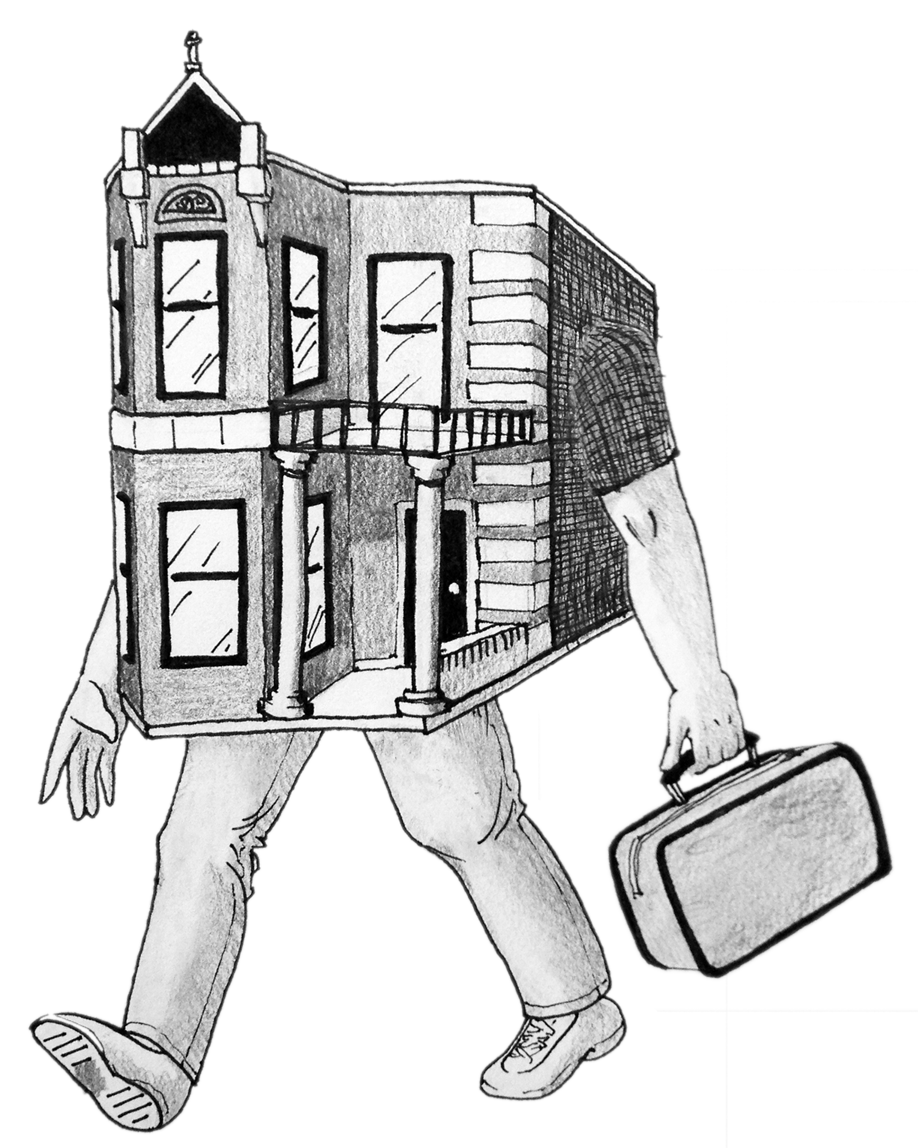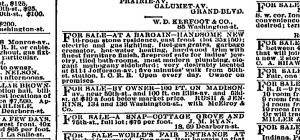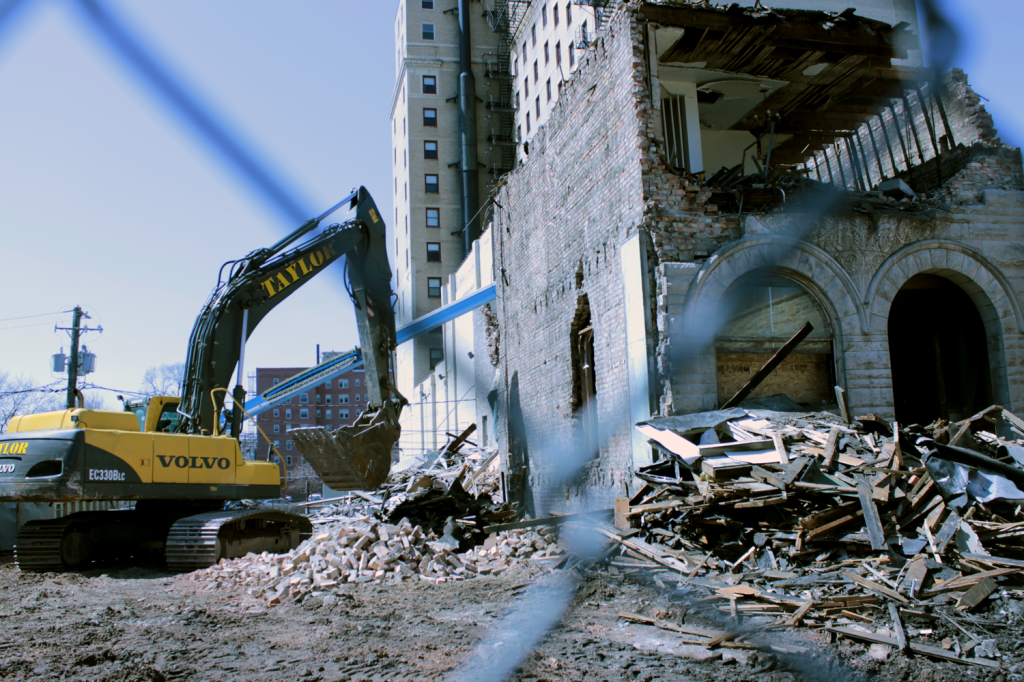
The 5100 block of South Harper Avenue in Hyde Park has been growing emptier these last few months. On the northern end of the block, what was once the Village Shopping Center is now a vast empty stretch bounded by tall construction fencing. Across the street, a smaller pile of rubble marks the former site of three adjoined greystone houses.
It’s hard to be devastated by the loss of the shopping center itself, an unglamorous suburban-style strip mall. But local preservationists are still struggling to make sense of the loss of the historic homes and determine whether changes can be made to align with their own goals.
The greystones were demolished to make way for a truck-turning area and a small private parking lot for City Hyde Park, an ambitious new development at the corner of Harper and East Hyde Park Boulevard. The project, led by Antheus Capital and designed by Studio Gang architects, includes plans for a Whole Foods and a high-rise of apartment units (“a new rental community of elegant living,” as the project’s website puts it). To some, the demolition marks a potential turning point in Hyde Park’s relationship with development: a sign that companies like Antheus Capital will continue to build, with little regard for preservationists and neighbors.
“Is this the start of a new relationship [of Antheus Capital] with Hyde Park, one that is based solely on cold calculations and the bottom line?” an editorial in the Hyde Park Herald asked bluntly last November.
Meanwhile, Jack Spicer, preservation chair of the Hyde Park Historical Society, says the greystones are an especially significant loss because they were a “vestige” of an area of Hyde Park that has been all but “obliterated by urban renewal.”

In July 2008, following Antheus’s purchase of the vacant homes, the Herald reported that the company wanted to restore them from a state of neglect and rat infestation in order to protect property values of the development planned across the street. Peter Cassel, a representative for Antheus, said then that the homes would likely be converted into nine rental apartments. However, in late 2013, Antheus, which owns a number of other properties in Hyde Park through MAC Property Management, announced that rehabilitation was not financially viable and that the homes would be demolished instead.
The three homes have been witnesses to sweeping transformations from their perch near the corner of Hyde Park Blvd. and Harper. Their history begins in 1892, when they were constructed at what was then 5110-5114 S. Jefferson Ave. This places them in the earliest years of Chicago’s greystone boom; between roughly 1890 and 1930, thousands of these homes were built in neighborhoods on the city’s South, West, and Northwest Sides.
In their early years, the homes were steps from the grand Hyde Park Hotel, and Hyde Park Blvd. was itself a lively commercial strip. Urban renewal projects made drastic changes to the neighborhood in the 1950s and 1960s, and the hotel was sacrificed for the Village Shopping Center, whose own rubble is now the future site of City Hyde Park.
The neighborhood has not forgotten the effects of urban renewal in the 1950s and 1960s—the Hyde Park Historical Society maintains a “Razed Buildings Collection” in the University of Chicago Library’s Special Collections, with hundreds of photographs showing structures that were demolished under the blight-elimination program.
“Development in the 1950s and 1960s era of urban renewal took an insensitive, heavy-handed approach,” says Ward Miller, president of Preservation Chicago. “It’s created a polarizing effect and a loss of so much historical fabric.”
Preservationists tend to view midcentury urban renewal as the poster-child for what Spicer calls “thoughtless” development, as contrasted with more “sensitive” procedures. And both Spicer and Miller mark the sacrifice of the greystones as an instance of the former. (Spicer calls Hyde Park’s latest wave of development “Urban Renewal 2.”)
But if the neighborhood is now living out the sequel, there’s still disagreement about what the ending will be.
Conversations with local preservationists reveal a lack of the militant anti-developer attitude one might expect of them, though they still regret the loss of the homes. Miller, for one, is a self-declared “eternal optimist,” who sees the new wave of development in Hyde Park as a second chance for change, an opportunity to improve on the poor planning implemented during urban renewal. “I’m not trying to hamper development,” he says. Instead, he’s in favor of a rethinking of the neighborhood’s commercial districts, many of which he thinks were changed for the worse.
Miller sums up the tension between preservationists and developers as competing answers to the same questions: “How can we grow a community holistically? What should be saved, and what should be rethought?”

Preservationists delight in the great architectural variety to be found in greystones; the term refers not to a single architectural feature, but rather to their distinctive Indiana limestone facades. Quarrying operations in southern Indiana were in full swing by this time, exporting the native stone to Chicago and other cities. Limestone had a reputation as a particularly fireproof material, well-suited to replace buildings lost in the Great Chicago Fire of 1871. Greystone structures, then, are one way that memory of the city’s rebirth is kept alive.
But there’s also the practical consideration: unlike some structures, greystones age well. Val Cavin is a community activist in North Lawndale, another part of Chicago’s greystone belt, who fights against the demolition of greystones in her neighborhood. She explains that greystones are “very solid.” Even if a greystone’s interior is in poor condition, she says, the limestone exterior can usually be restored.
Given that, Ruth Knack, president of the Hyde Park Historical Society and a writer on urban planning, points out that the demolition of the greystones also carries environmental costs. “The developers of City Hyde Park talk about it as being green development. But the most green form of development is preserving buildings that already exist.” Every building requires labor and resources, she says, and “old buildings embody the energy that went into constructing them.”
In addition to their structural stability, greystones can also provide community stability. “Greystones are an anchor in neighborhoods that have been distressed. Historical preservation is, in general, a tool to maintain diversity,” Cavin said. Buildings worthy of preservation have often been owned by people who have lived in them for a long time.” In the face of gentrification and disinvestment pressures, the preservation of historic homes is a way to fight back, preventing long-term residents with strong personal investment in their community from being edged out.
“If historical preservation is part of our development standards, we’ll get better outcomes,” maintains Miller. He and Preservation Chicago propose the creation of landmark districts to protect the neighborhood’s historic housing stock. Miller is quick to explain that landmark designation does not turn an area into a “museum piece,” in which homeowners lose all control of their property. The designation is limited to homes’ exteriors, not their interiors, and serves to create “living landmarks.”
But the Harper greystones are now gone, and the question for preservationists and concerned residents is how to bring such considerations to the table now, going forward.
“I don’t want to hang on the loss of three houses, Miller says. Ultimately, no one does—neither preservationists nor developers, though perhaps for different reasons.

Everyone loves what you guys are usually up too. This sort of clever work
and exposure! Keep up the fantastic works guys I’ve included you guys to blogroll.
The times have turned around. The Greystones are making a comeback. With redevelopment of them in every neighborhood in Chicago. I think it was truly stupid for them to take a masterpiece of a building a demolish them. So many of the buildings could have be converted back to single family homes as they are now doing.